Ice hockey equipment. How to put it on, washing & Co.
FAQ on equipment, costs and maintenance
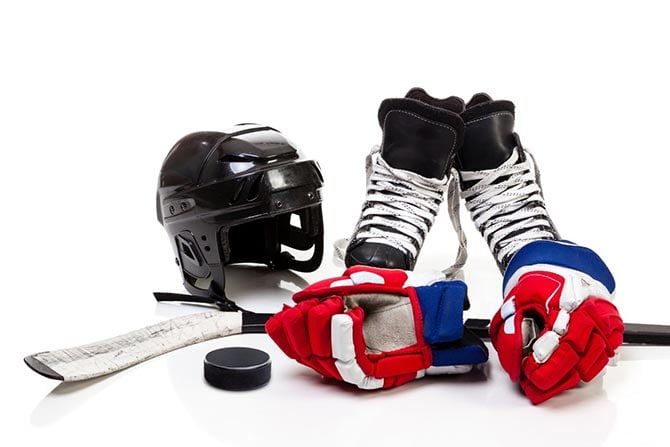
If you want to play hockey, being able to skate and shoot well are a good start. You'll also need the right equipment so you don't get hurt. In this article, we'll answer all your questions: what hockey equipment you'll need, how much it costs and how to wear it properly.
Hockey Pads & Protective Gear: Everything you need to know
What is inlcuded in hockey padding? How much does it weight, how do you put it on properly and how do you care for your jersey and equipment? You can find out all this here.
What makes padding good?
The game on the ice is intense: fast breaks, hits against the boards, sharp blades and a lightning fast puck make hockey exciting yet dangerous. In order to keep the risk of injury low, well-fitting and solid padding is extremely important. When buying your equipment, try not to save money. Find high quality gear that protects and fits right.
Good hockey equipment should
- protect against injury
- rescrict your range of movement as little as possible,
- be light
Shin guards or leg pads are essential to protect against bruises: the chest and shoulder area in particular must be well protected. Elbow, knee and shin guards are also essential.
The head is protected by a good fitting hockey helmet: The outer shell is made of hard plastic and withstands shocks. The foam inside the helmet protects the head of the player. The chinstrap can be adjusted so that the helmet fits snuggly and does not move. Additional ear protection is recommended.
The skates need to withstand enormous strain and fit well so that there are no injuries to the foot or ankle. The skate should fit tightly and the laces bound firmly so that the shoes fit snuggly.
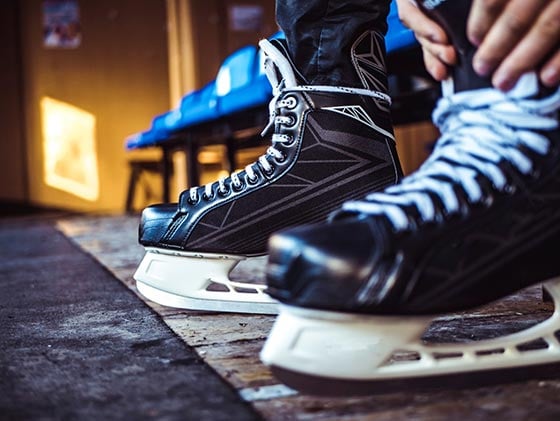
Did you know? The blades of hockey skates are sharpened differently than, for example, the blades of ice skates. They are shorter than the skate itself and have a high curvature (so-called rocker), which means that the skates have a relatively small area of contact with the ice. This makes its wearer particularly nimble and able to quickly change direction - which is particularly relevant for forwards. Defenders usually use skates with longer rockers as defensemen so they are more stable and can glide quicker.
Hockey Equipment: What's included?
In principle, the same components belong to the equipment of the goalie and players. If you are a goalie, you need some extra padding.
Equipment for players
Hockey players need to have the following equipment:
What's included
- Helmet (with plexi or grid visor)
- Chest pad
- Neck protector
- Jersey
- Elbow pads
- Gloves
- Thermal underarmor
- Nut cup
- Leg pads
- Pant shells
- Hockey socks
- Skate protectors
- Shin pads
Tip: When training off the ice, we recommend the Fitness Jersey in design of your hockey jersey.

Necessary Equipment
- Puck
- Ice hockey stick
- Ice hockey bag
By the way: We recommend using tape on your hockey socks so that your shin guards don't slip while playing. Alternatively, go with Hockey Socks with velcro to secure the socks to your pants. Also tape your stick for added grip.
Special goalie equipment
Goalies need the same basic equipment as players. However, goalminders have extra equipment, such as
- Goalie Mask
- Neck Protector
- Chest Protector
- Jock Strap
- Catching Glove and Blocker
- Leg Pads
How are hockey jerseys sized?
How do you find the right jersey size? We recommend that you order Samples to try on from us. That way, you can find the size that fits best for you.
Alternatively, our size chart can help you find the right size based on your measurements. Just measure your chest circumference by measuring around the widest part of your chest.
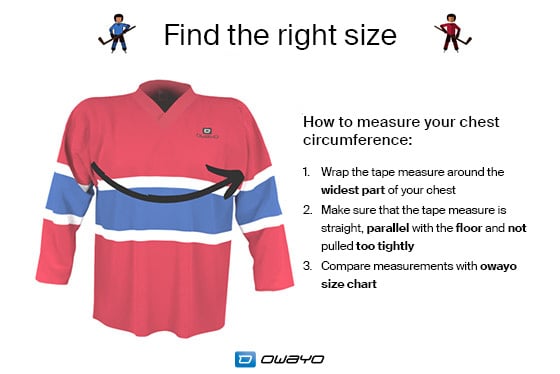
By the way: With us you can order all jersey sizes as goalie sizes - the main difference is the sleeves. The sleeves on the goalie jersey are wider to accommodate the added gear. You can also choose the type of collar, whether soft, breathable or robust. Our jerseys also feature a mesh insert at the arm pits for added ventilation. »» Discover your design options now
How do you put on your hockey gear?
We've already mentioned that hockey players wear many kinds of padding. But how do you put on a jock strap, jersey, pant covers, chest pads, etc.?
In the following video, Marcel from "Marcel's Hockey School" shows you how to wear padding:
How much does hockey equipment cost?
How much your hockey gear costs depends on your experience. Depending if you are a beginner or professional, or want to buy hockey equipment for your child, the cost will depend on your situation.
Beginners: For beginners you should expect to pay about 200 Euros/Dollars - for the helmet, stick, gloves and skates.
Advanced/Professionals: If you are looking for higher tier gear, you can expect to spend between 500 and 1,000 Euros.
Children: If your child wants to play hockey, it is not absolutely necessary to buy expensive protective equipment immediately. Your local hockey club may offer introductory courses and provide the equipment. Or you can buy clothes from other hockey parents whose children have outgrown them.
Were you aware? Ice hockey sticks used to be made of wood, nowadays they are made of composite materials like carbon. They do not shatter as easily as wooden sticks, but wear is enormously high, especially in professional leagues: Pro Stock Hockey states that "Blackhawks equipment manager Troy Parchman said in 2015 that his team typically breaks at least two to three sticks per game".

How heavy is hockey equipment?
Ice hockey players generally carry a lot of equipment, and that means a lot of weight. The equipment for field players weighs around eight kilograms. Goalies can have have up to 20 kilograms of padding:
- Leg Pads: approx. 5 kg
- Skates: approx. 2.5 kg
- Catching glove and blocker: approx. 2 kg
- Stick: approx. 1 kg
- Add to that the mask, jock strap and other padding.
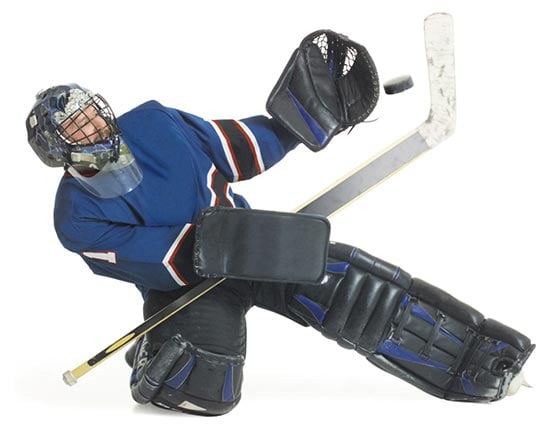
How to wash and store hockey equipment
Pooh, that stinks! So that the equipment doesn't smell too bad, you should hang it up immediately after playing to dry. If the used clothing stays in the hockey bag until the next practice, bacteria could start growing. This means: Your hockey gear can get moldy if you don't air it out.
Instead of hanging up your equipment after training, you can also store it after drying in airtight plastic boxes to prevent unpleasant odours.
Tip: Antibacterial sprays can help to reduce odour.
Wash your functional clothing you wear under your gear. Read in our magazine how to wash and care for your sportswear properly.
The following video will show you how to wash the different parts of your hockey gear properly:
Individual hockey sportswear for your team
Ice hockey jerseys not only protect the players, they provide a unifying effect for the team. Create a unique ice hockey jersey that will make your team stand out.
Here are some examples design our customers have come up with:
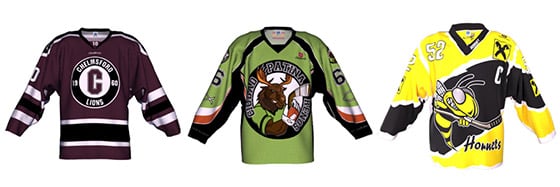
Discover ice hockey products in the owayo shop and design your own custom hockey sportswear!
Or read more about ice hockey in our magazine:
Picture credits: © gettyimages/ronniechua; Picture 1, 3, 4: owayo; Picture 2: © gettyimages/Mikhail Rudenko; Picture 5: © gettyimages/francisblack; Picture 6: © gettyimages/Photodisc.